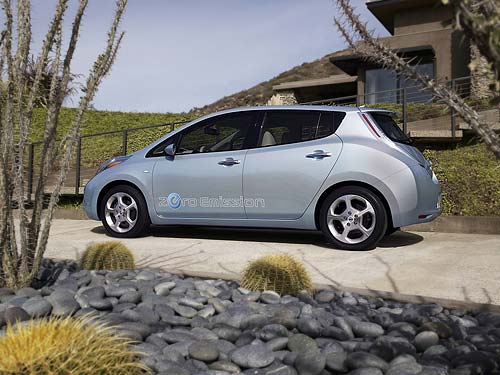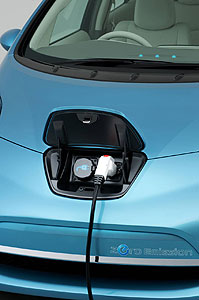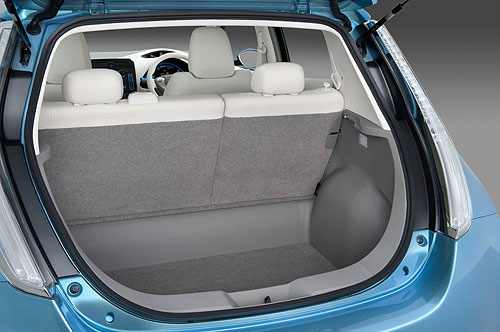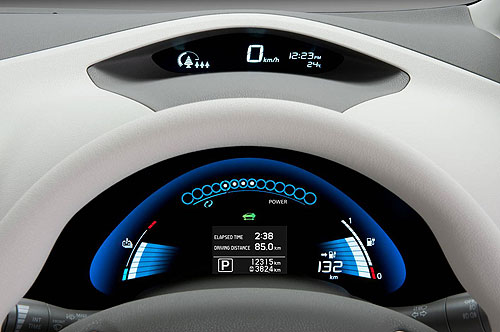 Scheduled for launch in late 2010 in Japan, the United States, and Europe, Nissan LEAF ushers in a new era of mobility – the zero-emission era. The Nissan Leaf is the embodiment of Nissan’s vision for the future and the culmination of years of investment and research.
Scheduled for launch in late 2010 in Japan, the United States, and Europe, Nissan LEAF ushers in a new era of mobility – the zero-emission era. The Nissan Leaf is the embodiment of Nissan’s vision for the future and the culmination of years of investment and research.
Key characteristics of the LEAF include:
1) Zero-emission power train and platform
2) Affordable pricing – although ‘affordable is a relative term and recent reports suggest that it could hit the showrooms in Australia with a list price of anywhere between $33,000 and $39,000 at current exchange rates.
3) Distinctive design
4) Real-world range autonomy – 160km (100 miles)
5) Connected Mobility: Advanced intelligent transportation (IT) system
Pricing details will be announced closer to start of sales in the United States – expected to begin in late 2010; however, the company expects the car to be competitively priced in the range of a well-equipped C-segment vehicle. Additionally, Nissan LEAF is expected to qualify for an array of significant local, regional and national tax breaks and incentives in markets around the world.
ZERO-EMISSION MOBILITY
Nissan LEAF is powered by laminated compact lithium-ion batteries, which generate power output of over 90kW, while its electric motor delivers 80kW/280Nm. This ensures a highly responsive, driving experience that is in keeping with what consumers have come to expect from traditional, gasoline-powered automobiles.

Unlike internal-combustion engine (ICE) equipped vehicles, Nissan LEAF’s power train has no tail pipe, and thus no emission of CO2 or other greenhouse gases. A combination of Nissan LEAF’s regenerative braking system and innovative lithium-ion battery packs enables the car to deliver a driving range of more than 160km (100 miles) on one full charge*.
(*US LA4 mode)
 Extensive consumer research demonstrates that this range satisfies the daily driving requirements of more than 70% of the world’s consumers who drive cars. And, Nissan has set out to make charging easy and convenient.
Extensive consumer research demonstrates that this range satisfies the daily driving requirements of more than 70% of the world’s consumers who drive cars. And, Nissan has set out to make charging easy and convenient.
Nissan LEAF can be charged up to 80% of its full capacity in just under 30 minutes with a quick charger. Charging at home through a 200V outlet is estimated to take approximately eight hours – ample time to enable an overnight refresh for consumer and car alike.
REAL-WORLD CAR
The engineers and designers behind Nissan LEAF worked to create a competitively priced real-world car that would enable Nissan to lead mobility into the zero-emission era. To ensure comfort, spaciousness and cargo capacity, Nissan LEAF employs a completely new chassis and body layout.
“Our car had to be the world’s first, medium-size, practical EV that motorists could afford and would want to use every day. And that’s what we’ve created. The styling will identify not only Nissan LEAF but also the owner as a participant in the new era of zero-emission mobility,” said Masato INOUE, Product Chief Designer.
DISTINCTIVE DESIGN
Even the smallest details can yield tremendous effect.
Nissan LEAF’s frontal styling is characterized by a sharp, upright V-shaped design featuring long, up-slanting light-emitting diode (LED) headlights that employ a blue internal reflective design that distinguishes this car from any other But the headlights do more than make a statement; they are also designed to cleverly split and redirect airflow away from the door mirrors, thus reducing wind noise and drag.

The headlights provide yet one more benefit in that they consume about 50 percent of the electricity of conventional lamps, which reduces the drain on the battery.
Through bright trim colors inside, Nissan LEAF creates a pleasing and stylish cabin environment. The “blue earth” color theme that has been used on the prototype is carried into the interior through blue dashboard highlights and instrument illumination.
CONNECTED MOBILITY IT SYSTEM
Nissan LEAF employs an exclusive advanced IT system. Connected to a global data center, the system can provide support, information, and entertainment for drivers 24 hours a day.

The dash-mounted monitor displays Nissan LEAF’s remaining power – or “reachable area” – in addition to showing a selection of nearby charging stations. This is important because Nissan believes that it will help overcome any range anxiety that may worry a driver Another state-of-the-art feature is the ability to use mobile phones to turn on air-conditioning and set charging functions – even when Nissan LEAF is powered down. An on-board remote-controlled timer can also be pre-programmed to recharge batteries.
“The IT system is a critical advantage,” says Tooru ABE, Chief Product Specialist. “We wanted this vehicle to be a partner for the driver and an enhancement for the passengers. We also wanted this vehicle to help create a zero-emission community, and these IT features will help make that possible.”
WORLDWIDE PARTNERS
Zero-emission mobility programs under the banner of the Renault-Nissan Alliance include partnerships with countries such as the UK and Portugal, local governments in Japan and the USA, and other sectors, for a total of nearly 30 partnerships worldwide.
In these partnerships major efforts focus on three areas:
1) Development of a comprehensive charging infrastructure through public and private investment,
2) Incentives and subsidies from local, regional, and national governments, and
3) Public education on the individual and societal benefits of zero-emissions mobility.
And just this week Renault-Nissan entered into one of these partnerships with the New South Wales state government.
ZERO-EMISSION VEHICLE PRODUCTION
Nissan LEAF is the first in the company’s forthcoming line of EVs and is a major milestone in the realization of the Renault-Nissan Alliance’s vision for zero-emission mobility.
The first of Nissan’s EV’s will be manufactured at Oppama, Japan, with additional capacity planned for Smyrna, Tennessee, USA. Meanwhile, lithium-ion batteries are being produced in Zama, Japan, with additional capacity planned for the USA, the UK and Portugal, and other sites for investment are under study around the world.
This post was compiled from an edited Nissan press release and the author’s notes